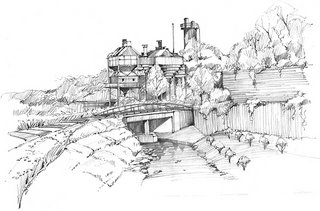Their work encompassed two geographical areas in the city: the Crab Creek river basin and the land adjacent to the convention center downtown.
The Crab Creek runs south from Trumbull County separating the north and east sides of the city, eventually merging with the Mahoning River near the downtown. Miles of industrial property runs along banks of the Crab Creek, which currently has no public access. Their plan includes opening the river to the public again by incorporating features such as pedestrian and bike trails, an “industrial garden”, and an “adventure site” for younger children. You can see their entire presentation here.

I really like the industrial garden idea. It includes illuminating old loading hoppers along the river as a central focal point, incorporating old railroad ties for benches and landscaping, and reusing older buildings for restrooms and meeting and exhibition spaces.
The second presentation (found here) includes ideas for what to do with the land sandwiched between the Market Street Bridge and the South Avenue Bridge near the convocation center. It included building a ramped walkway to the river above the railroad tracks and an amphitheater among others.

One additional presentation on the website gives an overview of the reuse of industrial property in the Emscher Area of the Ruhr Valley. Remember my World Cup blog last week about the area around Essen feeling like Youngstown? – well this presentation backs up that idea. It includes examples of using creative lighting, recreational areas, residential developments, and commercial successes to enhance existing industrial areas.

They close with these important conclusions:
- derelict industrial areas have value
- protect existing structures
- new uses are essential
- new implementation methods are needed
- establish a financial framework before beginning
- place emphasis on long range solutions
So can these concepts on paper become reality?




2 comments:
who would EVER put their foot in the mahoning river? (as illustrated in the drawing).
did you know the convocation center is actually built on a flood plane? i'm sure you did.
i like the idea of turning an old abandoned mill building into a rock climbing wall. i would be motivated to climb to the top of that, unlike an indoor wall, which is so pointless because you have to drop down as soon as you reach the pinnacle.
i don't think ytown is ready for something this progressive. or maybe i'm just saying that because the mahoning river is SO GROSS that i can't see how it could ever be beautified. and also, the hobos wouldn't like it one bit!
-- b
The drawing is actually of a pool of water adjacent to the river.
It is part of a design of a series of basins filled with different types of plant life to filter runoff water - a very eco-friendly concept.
An there are plans with the Army Corps of Engineers to clean up the river...a new post this week will cover that subject.
Post a Comment